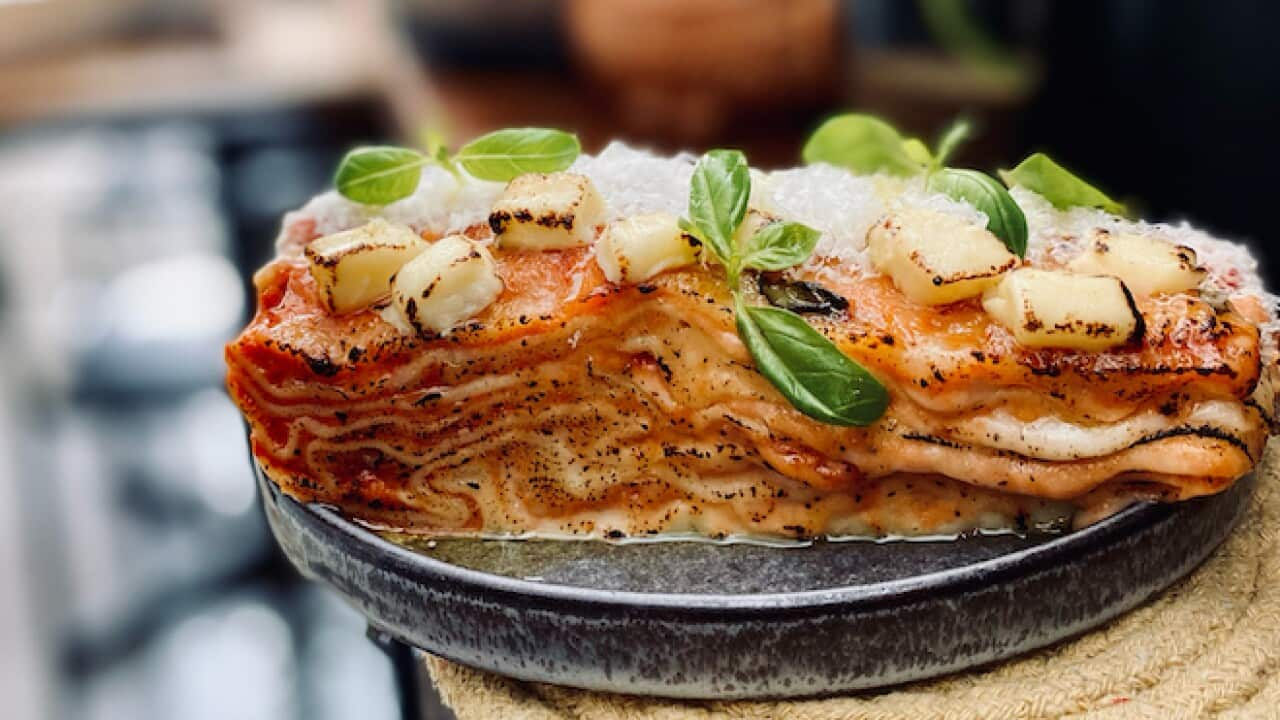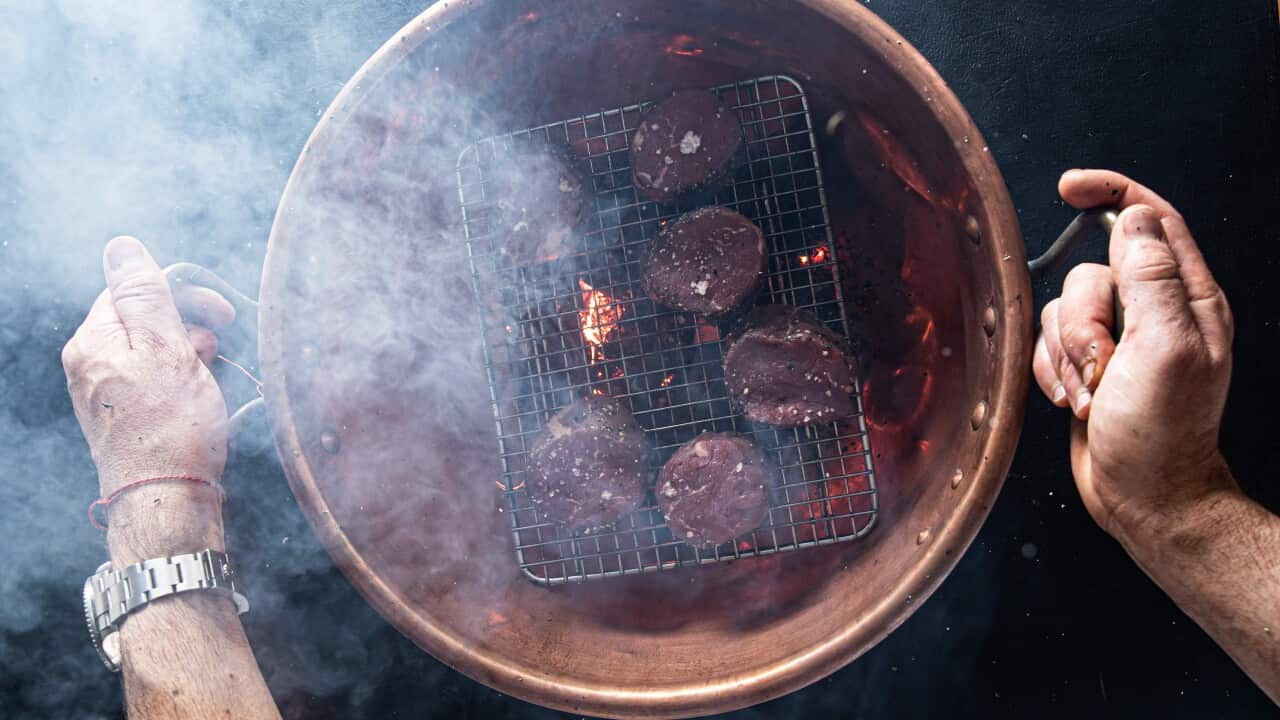For Mattia Aloisio, lasagne is a symbol of his childhood, family and home. Born in Milan, Italy, Aloisio moved to Australia in 2011. Initially visiting for travel and adventure, he never intended to stay permanently. A chef by trade, Aloisio had previously worked in a number of luxury hotels in Sardinia, northern and central Italy, Switzerland and London. When he visited Melbourne, he instantly connected with the lifestyle, the European feel, and of course the thriving hospitality scene. He decided to work here as a chef for several years. All the while though, he longed to run a venue of his own. Aloisio is the co-owner of the , a restaurant which he opened in 2020 with his friend, business partner and fellow Italian native, Alessio Davidde. As the name suggests, the restaurant, which is based in the Melbourne inner-city suburb of Windsor, serves lasagne. Aloisio and Davidde wanted their business to focus on one thing but to do it well. They settled on lasagne since it not only conjured memories of their homeland but the culinary festivity and tradition of Italian Sunday lunches with family.
Aloisio is the co-owner of the , a restaurant which he opened in 2020 with his friend, business partner and fellow Italian native, Alessio Davidde. As the name suggests, the restaurant, which is based in the Melbourne inner-city suburb of Windsor, serves lasagne. Aloisio and Davidde wanted their business to focus on one thing but to do it well. They settled on lasagne since it not only conjured memories of their homeland but the culinary festivity and tradition of Italian Sunday lunches with family.

Lasagna Lab co-owner and chef, Mattia Aloisio. Source: Lasagna Lab
Lasagne remains a dish layered with memories for Aloisio. His nonna, Lina, was the culinary monarch in his family and commandeered the making of this dish. Despite being served on a Sunday, Lina's preparations began much earlier in the week at the local weekly market. Aloisio sometimes joined her on these excursions. "She was going stand by stand, checking the ingredients. She was also smelling the vegetables that she was using…for the flavour and to understand if it was in season," says Aloisio.
Lina had a ritualistic approach to creating the family lasagne. On Saturdays, she would make the bolognese sauce and assemble the lasagne. "I was waking up [on Saturdays] with the smell of bolognese in the whole house," Aloisio recalls. From as young as five years old, Aloisio was an unwitting participant in her process. Although he would be watching TV, Lina would explain each step to him while she was combining the lasagne. As a result of her repetitive verbal dictation over the years, Aloisio inevitably memorised the recipe.
I was waking up [on Saturdays] with the smell of bolognese in the whole house.
Today, it is her recipe which forms the backbone of one of the most popular lasagnes in his restaurant and the newly opened second location, Lasagna Lab Express, which serves lasagne takeaway. His only change to nonna Lina's bolognese sauce is the addition of sher wagyu beef. He also uses his nonna's béchamel recipe, which contains leek instead of onion, another tip imparted from her Saturday lasagne lessons. "I've always liked the flavour of leek, plus it gives a bit of sweetness to the béchamel," explains Aloisio.
Aloisio's twists on classic flavours have become somewhat his signature style, a nod to his background in fine dining. At both venues, Aloisio and Davidde have a fixed menu of five lasagnes, which includes the sher wagyu bolognese lasagne (their most popular) and flavours like truffle and porcini lasagne with cashew béchamel, or the pumpkin, mascarpone and amaretti lasagne with burnt butter béchamel and amaretti crumble. The tomato, basil and fior di latte mozzarella lasagne is another fresh take on the Italian classic, gnocchi alla Sorrentina.
"It was always a flavour that I loved to eat with gnocchi and I thought to bring it to the lasagne and finish it with thirty-six-month-aged parmesan to give it a nice kick," says Aloisio.
Every month, Aloisio and Davidde serve two to three lasagne specials with interesting pairings like salmon, asparagus and hazelnut lasange, or a five-cheese lasagne with shallot marmalade and crispy prosciutto.
Although nonna Lina has passed away, the ritual leading up to those festive Sunday lunches is at the heart of the Lasagna Lab, and her presence reigns strong. "Every time that I do the steps to build the lasagne it brings back memories," Aloisio says.
Photography by Lasagna Lab.
Love the story? Follow the author here: Twitter Facebook , Instagram .
Tomato basil and mozzarella lasagna (Sorrentina)
Serves 4
This lasagne is based on gnocchi alla Sorrentina, a typical recipe from Campania, Sorrento - a very famous town in this region.
The key ingredients are peeled tomatoes from Italy, fior di latte mozzarella, fresh basil and the best parmesan that you can find. We suggest using a 36-month-aged parmesan. Once the lasagne is cooked, we recommend resting it overnight and reheating it the next day (this is our nonna's little secret). You need a pasta machine or rolling pin, a stick blender and a liquid thermometer to make this recipe.
Ingredients
Fresh pasta
- 300 g plain flour
- 200 g semolina flour
- 4 large egg yolks
- 2 large eggs
- 50 g olive oil
Tomato sauce
- 30 ml olive oil
- 2 medium brown onions, chopped
- 3 garlic cloves, whole
- 1.5 kg canned Italian peeled tomatoes
- 200 ml water
- ¾ small bunch basil, leaves picked and finely chopped
- Salt and black pepper
Béchamel sauce
- 75 g unsalted butter
- 75 g plain flour
- 1.5 litre full cream milk
- 3 bay leaves
- Salt and black pepper
To assemble
- 500 g fior di latte mozzarella, diced
- 500 g parmesan, grated, aged 36 months
- ¼ small bunch basil, leaves picked and finely chopped
To serve
- 150 g parmesan, grated, aged 36 months
- ¼ bunch basil, leaves picked
Method
- Make the fresh pasta for the lasagne by mixing the two flours together in a medium-sized bowl and tipping the flour onto a workbench. In another medium-sized bowl, mix the eggs vigorously until they bubble. Make a well in the middle of the flour on the workbench and pour the mixed eggs and olive oil into the well. Use a fork to mix all the ingredients together until the mixture becomes shaggy.
- Work the mixture with your hands or by using a stand mixer. Once the mixture transforms into a dough, wrap it with some plastic wrap and let it rest for at least 30 minutes. Once the pasta has rested, roll and laminate the pasta with a rolling pin or a pasta machine (0.5 cm thick maximum). Cut little squares big enough to fill a 31cm x 18 cm x 5 cm baking dish. Set the squares aside on the working bench covered with a tea towel.
- To make the tomato sauce, open the can of peeled tomatoes. Meanwhile in a heavy-based saucepan, heat the oil on medium heat and fry the chopped onions and whole garlic cloves. When the onions and garlic cloves turn golden brown, add the peeled tomatoes, then 200 ml of water, ¾ small bunch basil (leaves picked and finely chopped), and salt and black pepper to taste. Cook this on low heat for 2 hours, stirring every 10 minutes. After 2 hours, blitz the tomato sauce with a stick blender until nice and smooth.
- For the béchamel sauce, begin by making a roux. To do this, melt the butter in a medium-sized heavy-based saucepan and add the flour to it. Cook this mixture for 2 minutes on medium heat. At the same time, add the full-cream milk and the bay leaves into another medium-sized heavy-based pot. Cook the milk on medium heat until it reaches 70°C and add the roux. Whisk the milk and roux continuously until thick (approximately 15 minutes). Remove the bay leaves and add salt and black pepper to taste, then stir the parmesan into the béchamel sauce.
- To assemble the lasagne, add a layer of béchamel, tomato sauce, diced fior di latte mozzarella and a sprinkling of parmesan and basil to the baking dish. Cover each layer with squares of fresh pasta, except the last. Create a total of five layers and let the lasagne rest for half an hour before baking.
- Preheat the oven to 200°C. Bake the lasagne by covering the top with some foil. Cook for 30 minutes then remove the foil and use the oven's grill setting at 200°C until the surface appears golden and crunchy (approximately 5 minutes).
- Let the lasagne rest for 10 minutes before serving. Add the last touch by sprinkling basil leaves and grated parmesan over it.
MORE ITALIAN FOOD

Italian chocolate custard (bonet)






